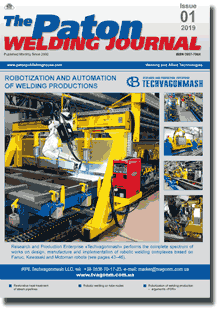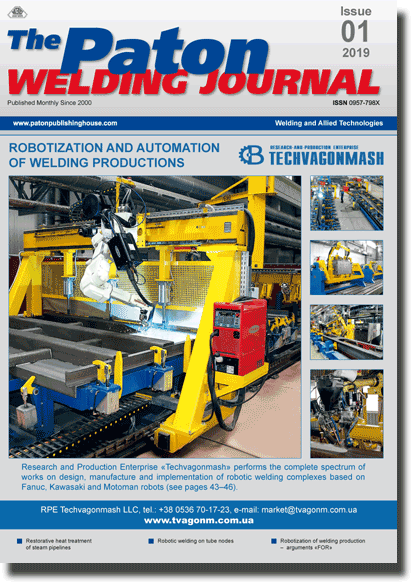| 2019 №01 (06) |
DOI of Article 10.15407/tpwj2019.01.07 |
2019 №01 (01) |

The Paton Welding Journal, 2019, #1, 33-37 pages
Journal The Paton Welding Journal
Publisher International Association «Welding»
ISSN 0957-798X (print)
Issue #1, 2019 (February)
Pages 33-37
Influence of modes of flux-cored strip surfacing on their welding-technological properties
A.P. Voronchuk, A.P. Zhudra, A.V. Petrov and V.O. Kochura
E.O. Paton Electric Welding Institute of the NAS of Ukraine 11 Kazimir Malevich Str., 03150, Kyiv, Ukraine. E-mail: office@paton.kiev.ua
Influence of surfacing modes on welding-technological properties of different types of high-alloyed flux-cored strips was studied. Electrode metal melting, surfacing, loss factors, as well as the efficiency of electrode material melting and deposition rate, were determined. As the objects of study, the flux-cored strips PL-AN-101 and PL-AN-179 made on a shel strip-sheath, as well as the strip PL-AN-111 on the bes on nickel sheath, widely applied in industry, were selected. Surfacing of samples for investigations was performed in A-874N machine with AD-167 attachment and VDU-1201 power source in a wide range of modes: current of 600–900 A, voltage of 32–40 V, speed of 32–55 m/h. Obtained results are presented graphically. It is found that alongside the surfacing modes, the filler-powder composition and sheath strip material have a significant effect on the characteristics of welding-technological properties of flux-cored strips and chemical composition and hardness of deposited metal, respectively. In surfacing with PL-AN-111 strip with a nickel sheath, having a high ohmic resistance, the more intensive heating of the flux-cored strip at the stickout takes place, and, consequently, the coefficient of electrode material melting is increased. Melting efficiency was lower in surfacing with PL-AN-101 and PL-AN-179 strips. At current rise, losses for burn-out and spattering become greater for PL-AN-111 strip, and change only slightly for PL-AN-101 strip, while for PL-AN-179 strip they decrease abruptly in the current range of 900–1200 A because of the specifics of powder-filler composition. Values of melting and surfacing factors, as well as melting and deposition efficiency decrease with increase of process speed for all the strip types. For PL-AN-111 strip, however, these values change only slightly. 7 Ref., 1 Table, 3 Figures.
Keywords: flux-cored strip, current, voltage, surfacing speed, melting and surfacing efficiency, losses for burn-out and spattering
Received: 21.11.18
Published: 13.02.19
References
1. Kuznetsov, L.D., Kortelev, G.A., Nikolaenko, N.R. (1982) Peculiarities of process of flux-cored strip surfacing on forced modes of parts of construction and road machines. Theoretical and technological principles of surfacing. Current methods of surfacing and their application. Ed. by I.I. Frumin. Kiev, PWI, 12–15 [in Russian].
2. Kuznetsov, L.D., Kurkumelli, E.G., Nikolaenko, M.R. (1983) Peculiarities of structure and properties of metal in surfacing with strip electrodes on forced modes. Wear-resistant and high-temperature steels and alloys. Surfacing materials. Kiev, PWI, 24–28 [in Russian].
3. Zhudra, A.P., Voronchuk, A.P., Kochura, V.O., Fedosenko, V.V. (2017) Effect of flux-cored strip surfacing modes on geometric parameters of deposited beads. The Paton Welding J., 1, 36–40. https://doi.org/10.15407/tpwj2017.01.06
4. Voronchuk, A.P., Zhudra, A.P., Petrov, A.V., Fedosenko, V.V. (2018) Influence of surfacing modes using flux-cored strips on chemical composition and hardness of deposited metal. Ibid., 4, 35–38. https://doi.org/10.15407/tpwj2018.04.07
5. Danilchenko, B.V., Shimanovsky, V.P., Voronchuk, A.P., Kopylets, I.P. (1989) Surfacing of high-wear parts with selfshielding flux-cored strips. Avtomaticheskaya Svarka, 5, 38–41 [in Russian].
6. Zhudra, A.P., Voronchuk, A.P. (2010) Wear-resistant surfacing with flux-cored strips. Svarshchik, 6, 6–9 [in Russian].
7. Zhudra, A.P., Voronchuk, A.P. (2012) Cladding flux-cored strips (Review). The Paton Welding J., 1, 34–38.
Suggested Citation
A.P. Voronchuk, A.P. Zhudra, A.V. Petrov and V.O. Kochura (2019) Influence of modes of flux-cored strip surfacing on their welding-technological properties. The Paton Welding J., 01, 33-37.The cost of subscription/purchase order journals or individual articles
| Journal/Currency | Annual Set | 1 issue printed |
1 issue |
one article |
| TPWJ/USD | 384 $ | 32 $ | 26 $ | 13 $ |
| TPWJ/EUR | 348 € | 29 € | 24 € | 12 € |
| TPWJ/UAH | 7200 UAH | 600 UAH | 600 UAH | 280 UAH |
| AS/UAH | 1800 UAH | 300 UAH | 300 UAH | 150 UAH |
| AS/USD | 192 $ | 32 $ | 26 $ | 13 $ |
| AS/EUR | 180 € | 30 € | 25 € | 12 € |
| SEM/UAH | 1200 UAH | 300 UAH | 300 UAH | 150 UAH |
| SEM/USD | 128 $ | 32 $ | 26 $ | 13 $ |
| SEM/EUR | 120 € | 30 € | 25 € | 12 € |
| TDNK/UAH | 1200 UAH | 300 UAH | 300 UAH | 150 UAH |
| TDNK/USD | 128 $ | 32 $ | 26 $ | 13 $ |
| TDNK/EUR | 120 € | 30 € | 25 € | 15 € |
AS = «Automatic Welding» - 6 issues per year;
TPWJ = «PATON WELDING JOURNAL» - 12 issues per year;
SEM = «Electrometallurgy Today» - 4 issues per year;
TDNK = «Technical Diagnostics and Non-Destructive Testing» - 4 issues per year.


